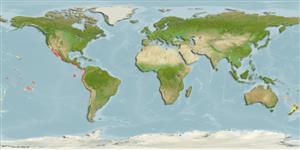>
Lophiiformes (Anglerfishes) >
Lophiidae (Goosefishes)
Etymology: Lophiodes: Greek, lophos = crest + Greek, suffix oides = similar to (Ref. 45335).
More on author: Garman.
Environment: milieu / climate zone / depth range / distribution range
Ecologia
marinhas demersal; intervalo de profundidade 15 - 311 m (Ref. 9538). Deep-water; 37°N -
Eastern Pacific: Baja California, Mexico to Peru. Range extends northward to the vicinity of Morro Bay, California (Ref. 36490).
Tamanho / Peso / Idade
Maturity: Lm ? range ? - ? cm
Max length : 40.0 cm TL macho/indeterminado; (Ref. 9538); common length : 30.0 cm TL macho/indeterminado; (Ref. 9538)
Descrição breve
Chaves de identificação | Morfologia | Morfometria
Espinhos dorsais (total) : 3 - 4; Raios dorsais moles (total) : 8; Espinhos anais: 0; Raios anais moles: 6 - 7; Vértebras: 19. Head and anterior part of the body depressed; posterior part of body gradually narrowing; back and sides of head with numerous spines; first dorsal fin formed by 3 isolated cephalic spines, the first of which resembles a fishing rod (bearing a scale that looks like "bait" and two prominent, dark "eyes") and three more short, thin, post-cephalic spines connected by a low membrane. Back brown or dark brown; belly lighter; fins darker distally but may have light edges; caudal fin with a vertical row of 6 pale spots (Ref. 55763). Head is flattened and mouth is large. The first two dorsal fin spines are displaced far forward (onto the snout), and the first is modified into a lure to attract prey. Branchiostegal rays: 6 (Ref. 36490).
Juveniles and adults are benthic on the continental shelf and the upper regions of the continental slope (Ref. 9538). Oviparous, with planktonic larvae (Ref. 36490). Eggs are contained in floating gelatinous rafts (Ref. 36490). Probably caught as a by-catch of trawl fishing (Ref. 9538).
Life cycle and mating behavior
Maturities | Reprodução | Spawnings | Egg(s) | Fecundities | Larvas
Oviparous (Ref. 36490). Eggs are contained in floating gelatinous rafts (Ref. 36490).
Caruso, J.H., 1995. Lophiidae. Rapes. p. 1227-1230. In W. Fischer, F. Krupp, W. Schneider, C. Sommer, K.E. Carpenter and V. Niem (eds.) Guia FAO para Identification de Especies para lo Fines de la Pesca. Pacifico Centro-Oriental. 3 Vols. FAO, Rome. (Ref. 9538)
Categoria na Lista Vermelha da IUCN (Ref. 130435)
Ameaça para o homem
Harmless
Utilização humana
Ferramentas
Relatórios especiais
Descarregue XML
Fontes da internet
Estimates based on models
Preferred temperature (Ref.
123201): 12.1 - 21.2, mean 15.1 °C (based on 106 cells).
Phylogenetic diversity index (Ref.
82804): PD
50 = 0.5000 [Uniqueness, from 0.5 = low to 2.0 = high].
Bayesian length-weight: a=0.01738 (0.01044 - 0.02894), b=3.00 (2.85 - 3.15), in cm total length, based on LWR estimates for this species & (Sub)family-body (Ref.
93245).
Nível Trófico (Ref.
69278): 4.5 ±0.80 se; based on food items.
Resiliência (Ref.
120179): Médio, tempo mínimo de duplicação da população 1,4 - 4,4 anos (Preliminary K or Fecundity.).
Fishing Vulnerability (Ref.
59153): Low to moderate vulnerability (30 of 100).
